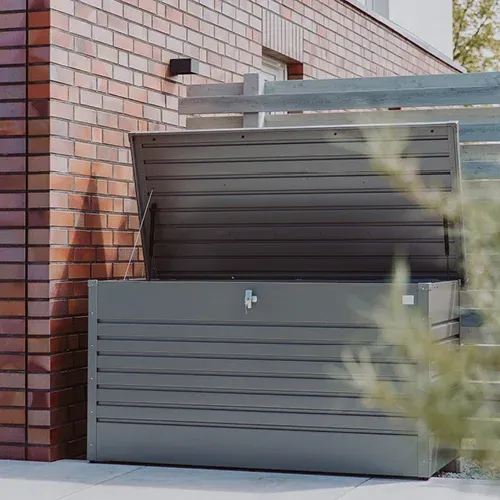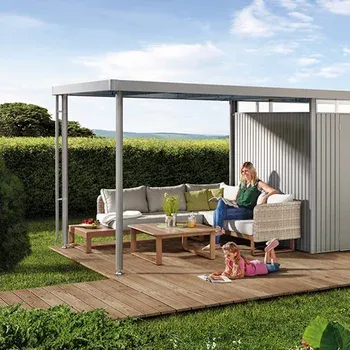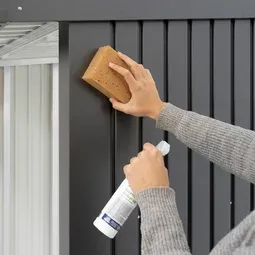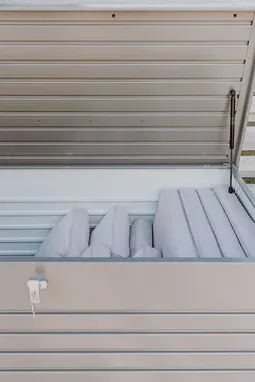Preparing garden furniture and terrace for the new season
Spring is fast approaching and the anticipation of a wonderful and, above all, relaxing time on your own terrace is growing. However, to ensure that you can really enjoy your terrace on the first beautiful spring days, you need to prepare your garden furniture and terrace for the new season in good time. Get to work, let's go! It needs to be cleaned, repaired, planted and decorated for spring. Sounds like a lot of work? Don't worry, because with our tips and tricks, it's easy and even fun at the same time.
In this blog post, you will find important tips on how to perfectly prepare your garden furniture and terrace for the new season.
- The right preparation for a beautiful terrace in spring
- What's the best way to clean your terrace?
- What's the best way to clean your garden furniture
- Make your own natural cleaning products
- Practical storage for seat covers and other items
- Decorate your terrace for spring
- Get your terrace ready for spring with early bloomers and plants
- Raised beds and planting beds for your terrace
- Bring plants out of hibernation
The right preparation for a beautiful terrace in spring
The first thing to do is to have a close looklook. Does the terrace have any damage or defects? Is the plaster crumbling, are the tiles loose or should the railings be repainted? Are the legs of the garden chairs wobbly or is the outdoor table not stable? Before the start of the terrace season is the ideal time to carry out minor repairs or improvements.
What's the best way to clean the terrace?
The dirt has to be removed! With many decking surfaces such as stone or concrete slabs, it is easy to remove coarse dirt and grime with a pressure washer. However, to make sure that the flooring can withstand the pressure washer, it is best to check in an inconspicuous area beforehand to ensure that no damage occurs. Care should also be taken with the joints to avoid damaging them unnecessarily. If it is possible to use a pressure washer without hesitation, this is a very simple and above all quick way to remove dirt and impurities from the decking.
Alternatively, you can of course use tried-and-tested tools such as a floor brush and broom, and not just for more sensitive decking. The motto here is very clear: the main thing is to clean the decking really thoroughly. A scrubbing brush can also be used for coarse dirt. If unwelcome weeds and moss have spread across the terrace, they need to be removed thoroughly. A joint brush or joint scraper is particularly suitable for this. It's best to make sure you get the plant and its roots so that the weeds don't grow back for a long time.
Ideally, you should choose a nice, sunny day to clean the terrace - it makes the work easier, it's definitely more fun and the radiant result is visible in no time at all.
What is the best way to clean the garden furniture?
As soon as everything has been cleaned and prepared on the terrace itself, it's time to clean the garden furniture. Depending on where the garden furniture has been stored over the winter, it may need more or less intensive cleaning. Garden furniture that has been stored indoors during the winter only needs to be dusted and is ready for use in no time at all.
Garden furniture that has been stored outside over the winter, on the other hand, is much dirtier and needs to be cleaned thoroughly. Dirty garden furniture is best cleaned simply with a mixture of water and a gentle cleaning agent. Home-made cleaning agents can also be used, more on this later. Attention: Abrasive cleaning agents and coarse cleaning cloths should be avoided as they can damage the surface of the garden furniture and leave unsightly scratches. When cleaning wooden garden furniture, cleaning agents should not be used at all. Ideally, the wooden furniture should only be wiped down with a damp cloth using clean water to remove dirt and grime. Faded areas on wooden garden furniture can simply be sanded down and re-oiled. This will make them shine again in new splendour.
Make your own natural cleaning agents
In addition to commercially available cleaning agents, you can also use natural cleaning agents that are easy to make yourself. Vinegar, bicarbonate of soda, citric acid and curd soap are proven household remedies for both light and heavy soiling and dirt. Soda is also a tried and tested cleaning agent - however, it should be noted that soda has a bleaching effect and is not suitable for materials such as glass, aluminium, marble and granite.
For anyone who would like to try their hand at making their own cleaning agent, here are some simple instructions. For 500 ml of all-purpose cleaner you need:
½ litre of warm tap water
1 tbsp curd soap (grated)
1 tbsp baking soda (in powder form)
1 teaspoon of lemon juice
Preparation of the natural all-purpose cleaner:
Dissolve the grated curd soap in warm water
Add the baking soda and lemon juice
Pour into a suitable container with a lid
Shake the mixture well
The DIY all-purpose cleaner is ready
Homemade, natural cleaning products have many advantages:
environmentally friendly
save money
less aggressive, gentler on materials
biodegradable
save plastic waste
Practical storage for seat cushions and such
Where to put the seat cushions, tablecloths, small garden tools, barbecue accessories and more? I'm sure many of you have asked yourselves this question. Ideally, all of these things should be kept within easy reach on the terrace and well protected from the wind and weather. Depending on how much space you have on your own patio, there are various storage solutions available. In practical and robust garden boxes, these items can be quickly and safely protected from rain, moisture and wind and generally stored overnight. And best of all: they are also visually eye-catching and the chaos on the terrace is eliminated in an instant. The garden boxes from Biohort are available in different sizes and designs and make it easy to find the perfect storage solution for your own needs and available space. An overview of the large selection of garden boxes can be found here.

Decorating the patio in spring
From now on, the fun part of the job starts for many and all decoration fans as well as flower and plant lovers will get their money's worth. It doesn't take much to create a true paradise on a patio. With the right decorations, you can conjure up a very special flair and a relaxed atmosphere in no time at all - turning your patio into an absolute feel-good place. You can get inspiration for designing your patio on Pinterest , for example, and easily save your ideas to boards. Instagram is also a great place to find ideas for patio design, and it's also worth browsing through garden and decorating magazines.
These decorations can be used on the patio:
Light chains and/or candles
Tablecloth
Colourful planters
Outdoor lamps
Outdoor cushions
Candles
Outdoor rug
Get the patio ready for spring with early bloomers and plants
Colourful flowers on the patio are particularly suitable for really getting into the spring mood. Depending on whether you want a colourful sea of flowers or just a splash of colour, you can bring different flowers onto your patio. Many flowers are so-called early bloomers and start to sprout and open their buds as soon as the first rays of sunshine appear. If you missed sowing in autumn, this is not a problem. Many early-flowering plants can also be planted later. As a rule, they then need about 3 weeks to sprout. If this takes too long, you should pay a visit to the nursery. There you can stock up on colourful flowers in matching pots, which you can immediately place on the patio and enjoy the splendour of the flowers. Whether it's a colourful mix or uniform and neutral flower pots - you can create beautiful highlights and perfectly express your own taste.
For all those who want to grow their own flowers, we have collected a few tips and tricks:
In order for the harbingers of spring to grow and flourish beautifully, the right planting depth and care are important when growing them. There is a simple rule that is very helpful here: Ideally, there should be 2-3 times as much soil above the plant bulb as it is tall itself.
Adding a little compost to the soil also makes it easier for the early bloomers to grow.
After planting, don't forget to water the flowers at regular intervals. But be careful: waterlogging should be avoided at all costs, as they don't like it at all.
Here is a small overview of colourful early bloomers for the patio:
crocus
primulas
hyacinths
tulips
camellias
pansies
Raised beds and planting beds for the terrace
Planting beds and planter box systems can also create a really beautiful eye-catcher on the terrace. Especially if you don't have your own garden, planting beds and flexible planter box systems are the perfect way to bring nature as close as possible to your home. Whether flowers and plants, fruit and vegetables or herbs - the possibilities for creative use are almost endless. Planter boxes can also serve as a natural room divider and give your terrace a whole new look. Here is an overview of the durable and easy-to-assemble flower and plant beds.
Bringing plants out of hibernation
As soon as the nights are frost-free and the daytime temperatures rise, plants that have been stored indoors for the winter can be brought out of the house or cellar. For particularly sensitive plants, it is worth reading a plant guide to find out when it is safe to put them outside.
And then what? Once all these steps have been completed, it's time to move on to the best part: enjoying your own terrace and spring to the full. We wish you a lovely, relaxing time on your now well-tended and spring-like terrace.





